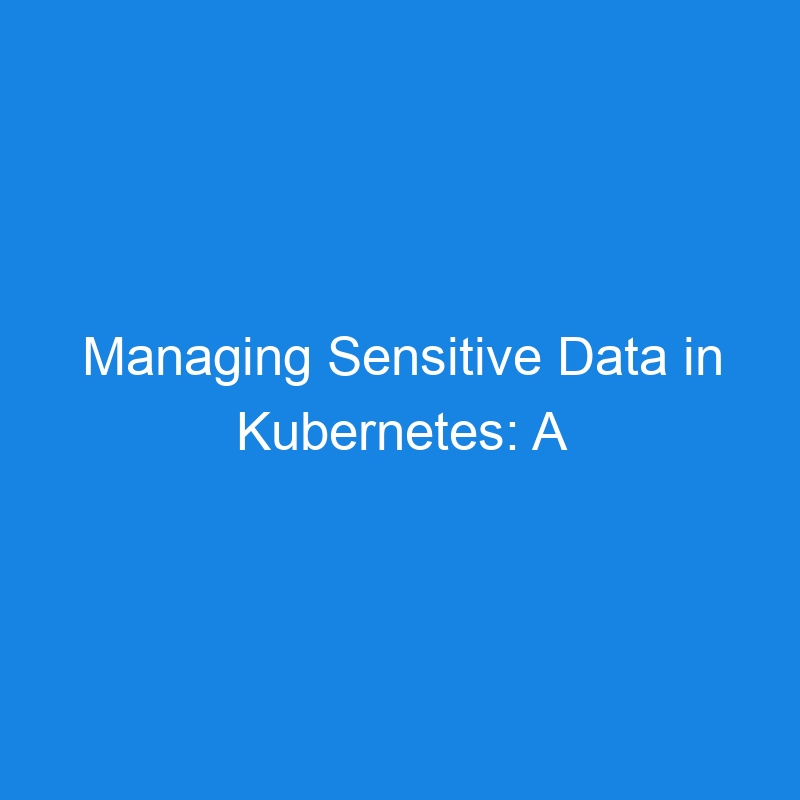A practical guide to implementing and managing Kubernetes Secrets with production-ready patterns
Introduction
In modern cloud-native applications move to Kubernetes, managing sensitive data like API keys, passwords, and certificates becomes increasingly critical. While Kubernetes Secrets offer a solution, implementing them correctly requires understanding various patterns and security considerations.
In this guide, I’ll share my experience implementing a production-ready secrets management system in Kubernetes.
Prerequisites
Before we dive in, you should have:
– Basic understanding of Kubernetes concepts
– Access to a Kubernetes cluster
– kubectl CLI installed
– Basic command-line knowledge
The Challenge
When I started working with Kubernetes secrets, I encountered several challenges:
- How to securely store sensitive data
- Implementing proper access controls
- Managing secret rotation
- Ensuring scalability
- Maintaining security best practices
Let’s see how to address these challenges step by step.
Key Concepts
What Makes Kubernetes Secrets Special?
Unlike ConfigMaps, Secrets in Kubernetes are:
– Base64 encoded by default
– Only distributed to nodes that need them
– Can be encrypted at rest
– Integrated with Kubernetes RBAC
Here’s a simple example of creating a secret:
kubectl create secret generic db-creds
--from-literal=username=admin
--from-literal=password=secretpass
Implementation Patterns
I’ve identified two main patterns for using secrets effectively:
1. Environment Variables
This is the simplest approach:
env:
- name: DB_USERNAME
valueFrom:
secretKeyRef:
name: db-creds
key: username
2. Volume Mounts
For more complex needs:
volumeMounts:
- name: secret-volume
mountPath: "/etc/secrets"
readOnly: true
Security Best Practices
Security isn’t optional. Here are the key practices I’ve implemented:
1. RBAC Implementation
Always use Role-Based Access Control:
kubectl create role secret-reader
--verb=get,list
--resource=secrets
2. Namespace Isolation
Keep your secrets isolated:
kubectl create namespace secure-env
kubectl config set-context --current --namespace=secure-env
Common Pitfalls
Throughout my implementation, I encountered several pitfalls. Here’s how to avoid them:
-
Base64 Encoding Confusion
- Base64 is not encryption
- Always enable encryption at rest
- Implement secure transmission
-
Access Control Issues
- Use granular RBAC policies
- Regularly review access
- Implement least privilege principle
-
Management Challenges
- Version control your configurations
- Schedule regular rotations
- Maintain backup procedures
Production Tips
Here are some tips from my production experience:
- Secret Rotation
kubectl rollout restart deployment myapp
- Monitoring Usage
kubectl get events --field-selector involvedObject.kind=Secret
- Regular Audits
kubectl auth can-i get secrets --as=system:serviceaccount:default:myapp
Complete Implementation
I’ve open-sourced my complete implementation on GitHub. It includes:
- Production-ready configurations
- RBAC templates
- Deployment patterns
- Comprehensive documentation
- Command references
- Troubleshooting guides
Find it here: k8s-secret GitHub Repository
What’s Next?
The project’s roadmap includes:
1. External secrets management integration
2. Automated rotation mechanisms
3. Enhanced audit capabilities
4. Multi-cluster synchronization
Getting Started
Want to implement this in your environment? Here’s how:
- Clone the repository
git clone https://github.com/TheToriqul/k8s-secret
- Review the documentation and examples
- Adapt configurations to your needs
- Implement security measures
Join the Discussion
I’m actively maintaining this project and welcome your input! You can:
- Star the repository
- Submit issues or suggestions
- Contribute improvements
- Share your experiences
Connect With Me
Let’s discuss Kubernetes security and DevOps practices:
- 📧 Email: toriqul.int@gmail.com
- 🌐 LinkedIn: @TheToriqul
- 🐙 GitHub: @TheToriqul

